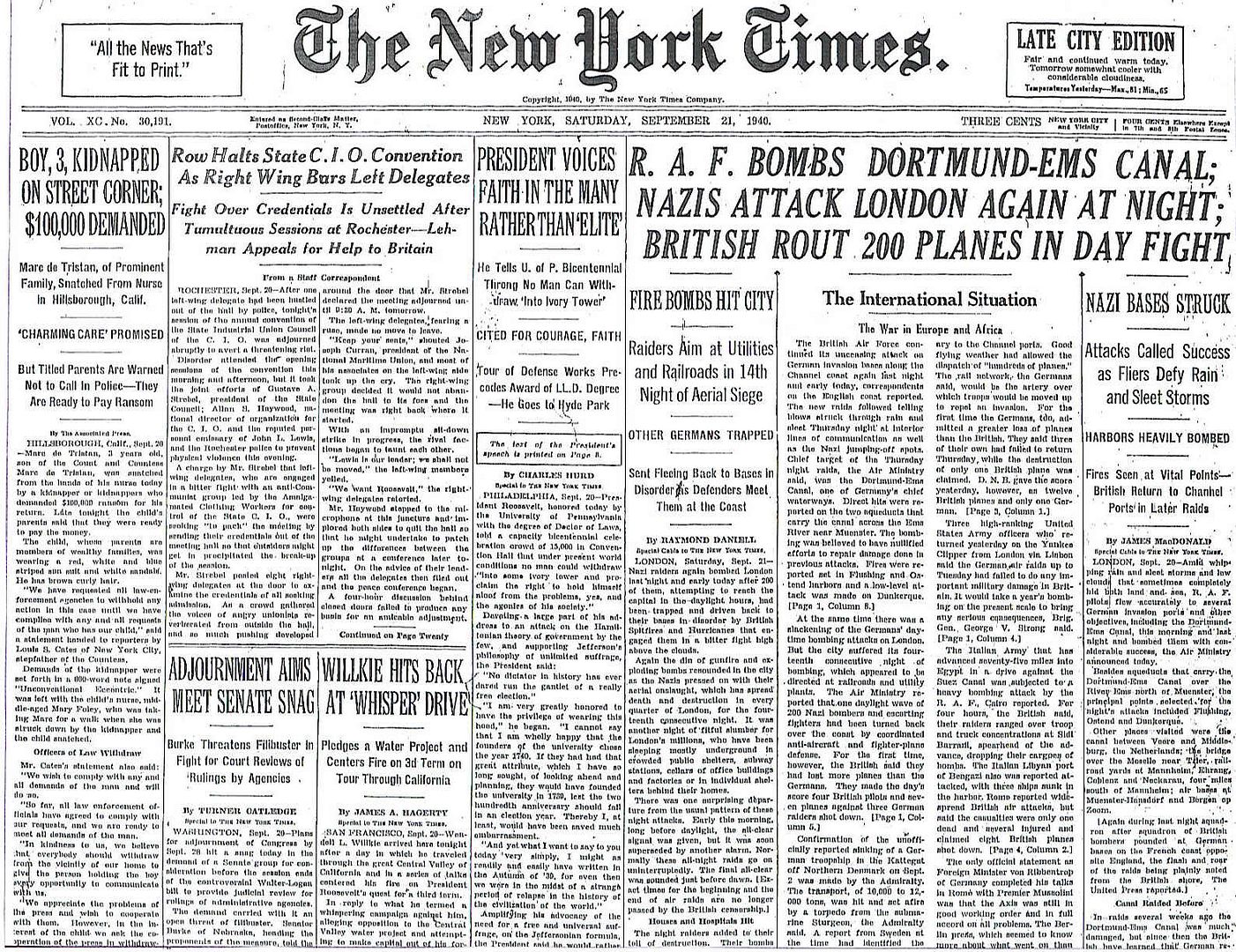
Posted on 09/21/2010 5:21:07 AM PDT by Homer_J_Simpson

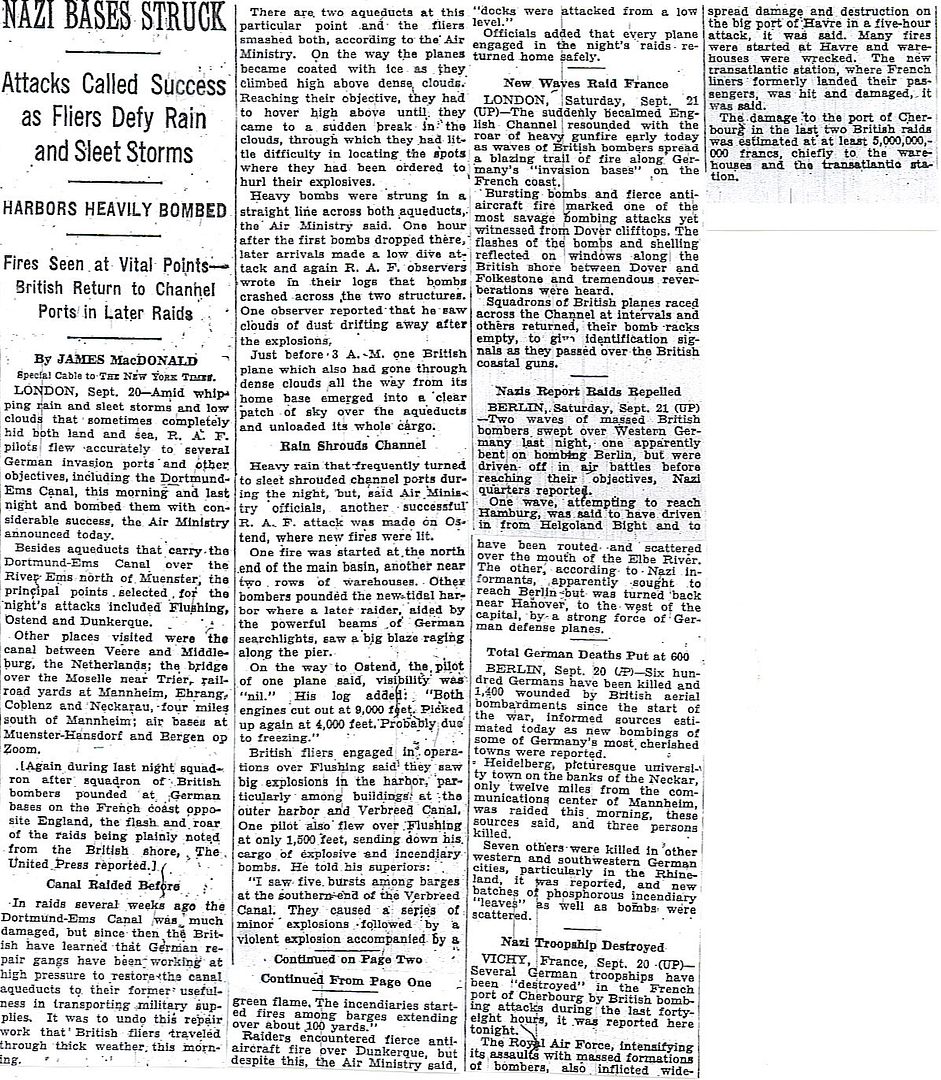
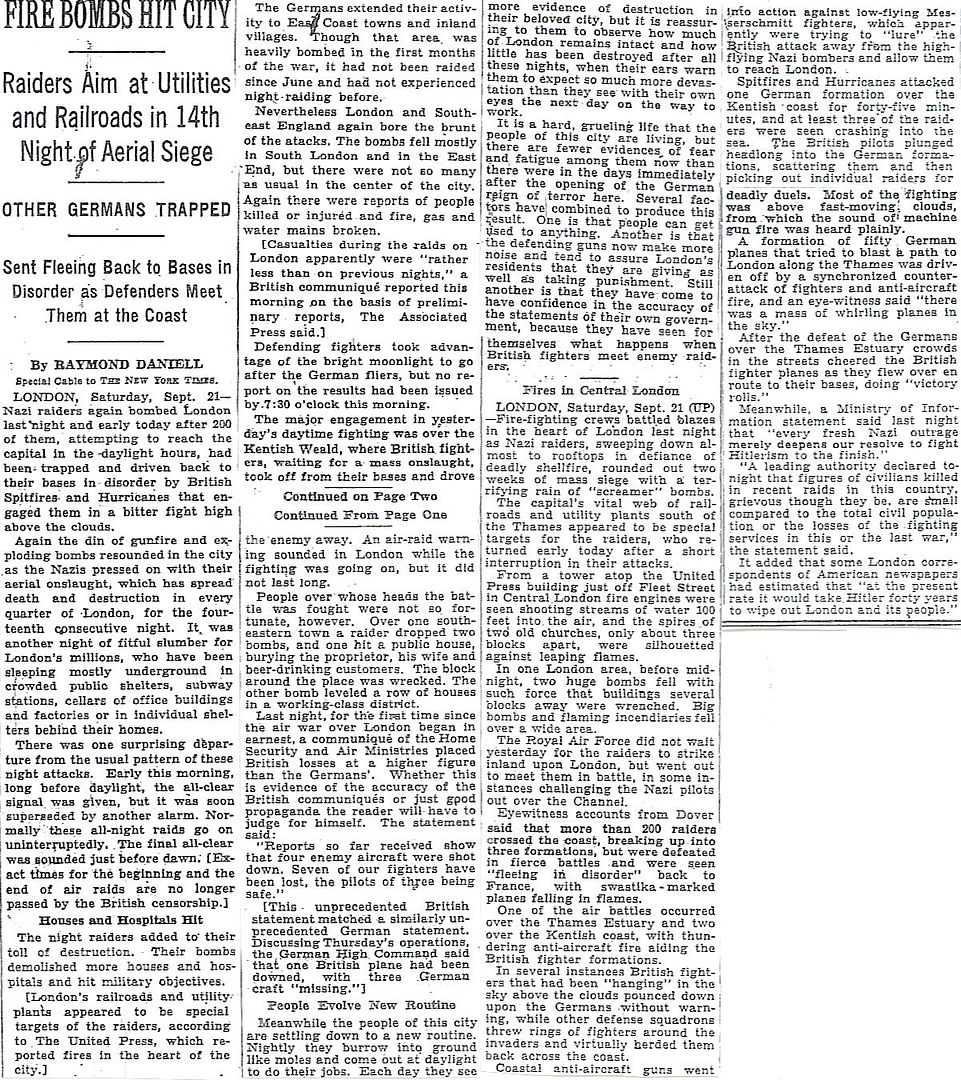
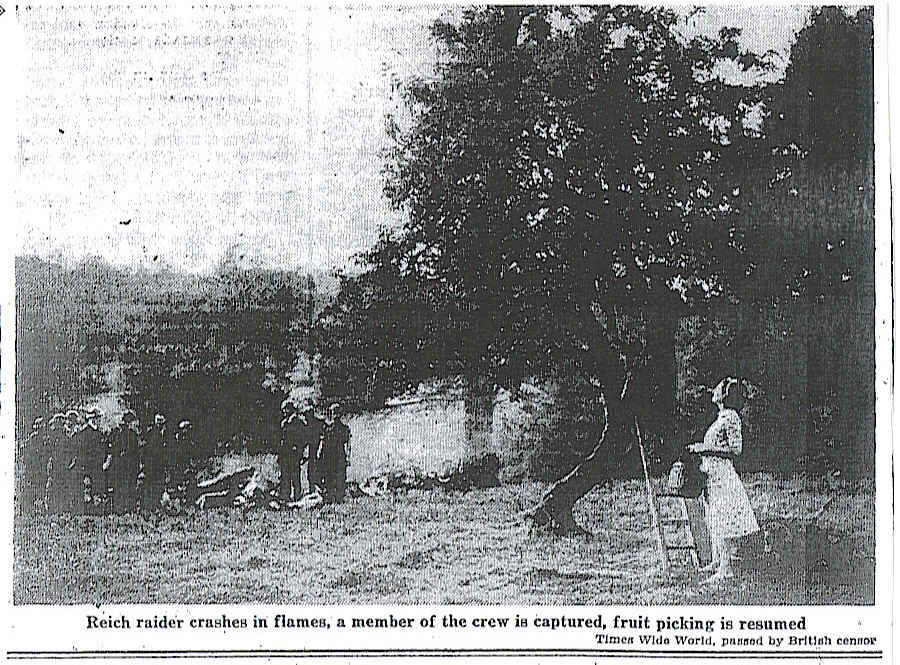
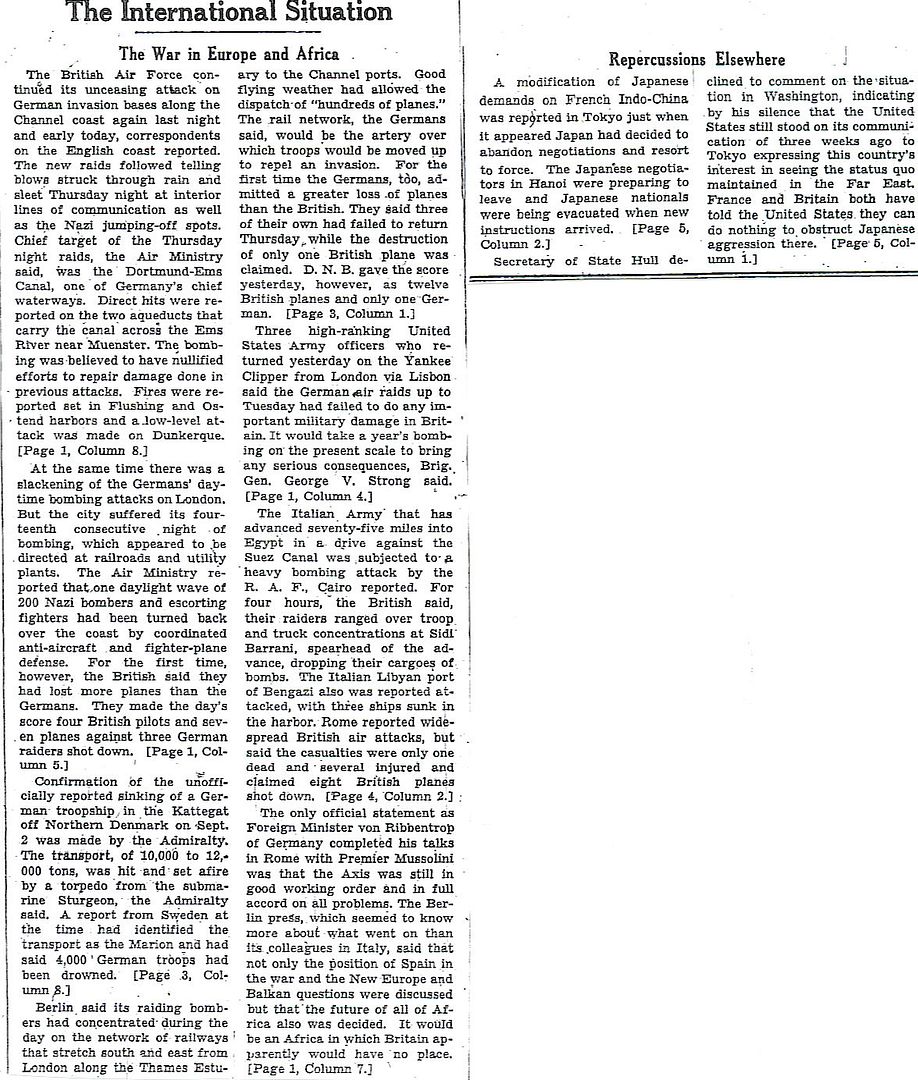
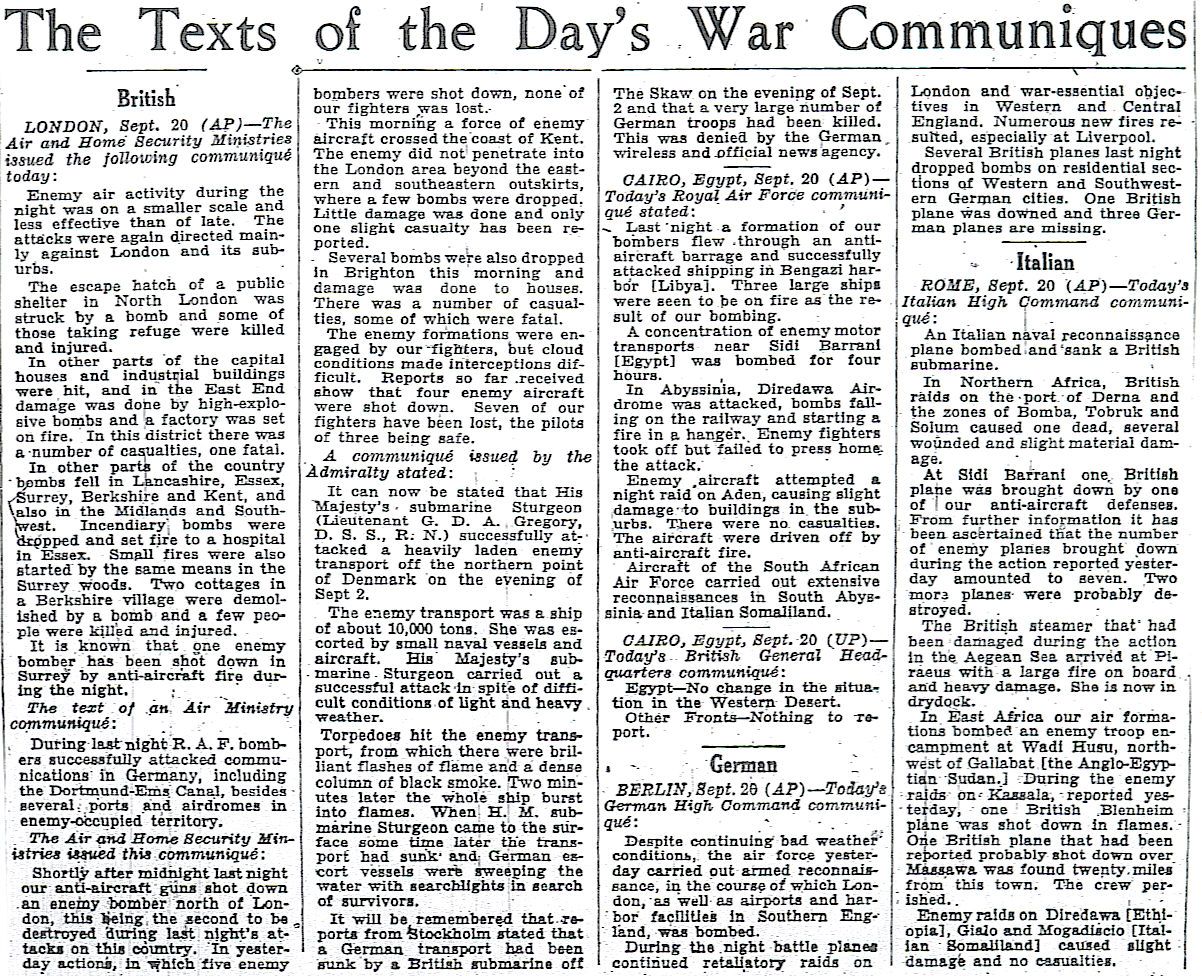
Plus a special guest map from Michael Korda’s, “With Wings Like Eagles,” showing the air defenses of England and Wales, August 1940.
http://www.onwar.com/chrono/1940/sep40/f21sep40.htm
London subway stations now bomb shelters
Saturday, September 21, 1940 www.onwar.com
Over Britain... As the night attacks on London continue, the government officially allows the subway stations to be used as air-raid shelters. This has been happening for some time.
In Australia... The election results are declared. Menzies remains prime minister. Labor is the largest party in both the House and the Senate but has no overall majority. Also, it is announced that the 9th Australian Division will be raised.
http://homepage.ntlworld.com/andrew.etherington/month/thismonth/21.htm
September 21st, 1940
UNITED KINGDOM: RAF Bomber Command: 4 Group. 51 Sqn. Whitley, P5105 overshot Dishforth on night operations. Sgt V.W. Bruce and crew safe.
Bombing - invasion fleet at Boulogne.
51 Sqn. Twelve aircraft. All bombed. Opposition severe.
78 Sqn. Ten aircraft. All bombed. Opposition severe.
London: To Churchill’s suggestion that one Pole is worth three Frenchmen, General Lord Gort replies that it is nearer ten.
London: Official permission is given to use the London Underground as an air raid shelter.
Battle of Britain:
Fighter-sweeps over east Kent. At night London and Merseyside are raided.
Small numbers of Ju88s were also making nuisance raids, one of Lehr 1 flying low-level to Brooklands and placing four bombs, three on the landing ground and one in the Hurricane assembly shop. The latter did not explode though until it had been removed from the building. [see below]
A parachute mine that delivered itself into central Ipswich could not be defused and had to be blown in-situ. The controlled explosion produced a crater 50 feet wide and 25 feet deep, demolished 70 houses, damaged 750 and broke windows 650 yards away.
Night raids on London dropped a mine on Hornchurch’s landing ground which failed to explode, seriously damaged Bethnal Green medical works and started a fire in Howard’s Timber Yard, Poplar, attended by 80 pumps [Fire Trucks in American].
Losses: Luftwaffe, 0; RAF, 0.
Weybridge, Surrey: Lt. John MacMillan Stevenson Patton (b. 1915), Royal Canadian Engineers, towed a bomb from an aircraft factory to a bomb crater, where it went off harmlessly. (George Cross)
Dagenham, Essex: Lt-Cdr Richard John Hammersley Ryan (b. 1903) and his assistant, CPO Reginald Vincent Ellingworth (b. 1898), who had shared many dangerous assignments, were killed when a sensitive magnetic mine, which was dangling from a parachute in a warehouse, went off as they tackled it. (George Cross for both)
Ilford, Essex: Mr. Leonard John Miles (b. ?), ARP, saved several lives when he left his air-raid shelter to warn others nearby of an unexploded bomb. He was fatally wounded when it went off. (George Cross).
Corvette HMS Nigella launched. (Dave Shirlaw)
GERMANY: U-154 laid down.
U-145 and U-146 launched. (Dave Shirlaw)
FINLAND: The Finnish negotiatior Juho Paasikivi, accompanied by Finance Minister Väinö Tanner, return to Moscow. (Mikko Härmeinen)
ATLANTIC OCEAN: U-100 sank SS Canonesa, SS Dalcairn and SS Torinina in Convoy HX-72.
U-138 sank SS Empire Adventure in Convoy OB-216.
U-47 damaged SS Elmbank in Convoy HX-72.
U-48 sank SS Blairangus and damaged SS Broompark in Convoy HX-72.
U-99 sank SS Elmbank, Empire Blythswood and SS Invershannon in Convoy HX-72. (Dave Shirlaw)
U.S.A.: The motion picture “City for Conquest” is released. This boxing drama, based on a novel by Aben Kandel, is directed by Anatole Litvak and stars James Cagney, Ann Sheridan, Donald Crisp, Frank McHugh, Arthur Kennedy, George Tobias, Elia Kazan and Anthony Quinn. The plot has Cagney as a fighter who is blinded with acid on the gloves of his opponent in a “fixed” fight set up by Kazan, a neighbourhood pal turned gangster. The blind Cagney then runs a newsstand and pays for his younger brothers (Kennedy) music lessons. (Jack McKillop)
CANADA: Corvette HMCS Arvida launched Quebec City, Province of Quebec. (Dave Shirlaw)
AUSTRALIA: A Federal election is held today. The United Australia Party narrowly retained government with the help of the Country Party. The United Australia Party won only 23 seats (and lost one when Arthur Coles declared himself an Independent) to Labor’s 32. The Country Party won 14 seats, Lang Labor 4 seats and there was 1 Independent. (Lang Labor was a breakaway group from the main ALP and was based in New South Wales - where the sacking of Jack Lang as Premier and the ALP reaction to the creation of the breakaway group. It had a love/hate relationship with the main party such that they were really torn when they had to choose between the “tories” and the ALP. They eventually amalgamated with the ALP through attrition. Arthur Coles (former UAP and founder of Coles Department stores) and Alex Wilson held the balance of power). (Daniel Ross)
http://worldwar2daybyday.blogspot.com/
Day 387 September 21, 1940
Battle of Britain Day 74. A very quiet day, despite fine weather. There are reconnaissance flights all day (2 German bombers shot down) and a 200+ aircraft raid towards London which is turned back at 6 PM. No RAF fighters are lost. London and Liverpool are bombed again overnight. British government sanctions the use of London Underground ‘Tube’ stations as air-raid shelters, which until now have been used unofficially by a growing number of Londoners. Tube stations are kitted out with food canteens, first aid facilities and chemical toilets. Some stations are equipped with bunks. One section of track is closed to trains and concreted over (the Aldwych branch of the Piccadilly Line), to allow storage of antiques and artifacts from the British Museum including the Elgin Marbles. http://www.raf.mod.uk/bob1940/images/21sept2.jpg
U-138 continues the attack on convoy OB-216, 10 miles off Malin Head, Ireland. At 2.27 AM, U-138 torpedoes British SS Empire Adventure (21 crew lost, 18 rescued) which is taken in tow but sinks on September 23.
Convoy HX-72 (41 merchant ships from Halifax, Nova Scotia, to Britain, protected by 4 Royal Navy destroyers, 1 sloop and 2 corvettes) is mauled by a wolf pack of 9 U-boats, 400 miles West of Ireland. Günther Prien in U-47 spots the convoy, but he has only 1 torpedo and calls for help. From 3.12 to 4.47 AM, U-99 torpedoes 3 ships which all eventually sink; British tanker Invershannon (16 dead and 32 survivors), British SS Baron Blythswood (all 34 hands lost) and British MV Elmbank (2 dead and 54 survivors). At 6.14 AM, U-48 sinks British SS Blairangus (6 dead and 28 survivors). At 11.10 PM, U-100 torpedoes and sinks British steamers Canonesa (1 dead and 62 survivors), Dalcairn (all 48 hands rescued) and British tanker Torinia (all 55 hands rescued). At 11.38 PM, U-48 gets back in the action, damaging British SS Broompark (1 crew killed).
http://www.uboat.net/ops/convoys/convoys.php?convoy=HX-72
The flotilla of ships to support the Free French landings at Dakar (Operation Menace) leaves Freetown, Sierra Leone. This includes aircraft carrier HMS Ark Royal, battleships HMS Barham and Resolution, cruiser HMS Devonshire, numerous destroyers and troop transports as well as French sloops Commandant Domine, Commandant Duboc and Savorgnan De Brazza. They will be joined at sea by cruisers HMS Cumberland and Dragon and HMAS Australia.
Memories from WWII, when I was 14 years old in high school and on the flat roof top of our school, where we had school break eating our brown bag lunches, about two miles from where the French school unfortunately was bombed. We saw the planes flying very low above our heads and pilots waving to us. I’ll never forget it, see the video link and link to the whole story of history!!!
http://195.231.246.70/agent/style/besat/Default.aspx?22691

RAF Mustang over Copenhagen
That building looks like an insurance company building on the City Square (Raadhuspladsen) only a few blocks from the Shellhus!!!
Date: 21st September 1940

Enemy action by day
Enemy reconnaissances were active along the East, South and South West Coasts during the day and attacked some isolated objectives.
In the evening a strong formation, consisting mainly of fighters, made a sweep over Kent and the Estuary, some penetrating to the eastern boundary of Central London. During the day our fighters destroyed 2 enemy aircraft (plus 1 probable plus 6 damaged). Our casualties were nil.
Major Attack
Between 1750 and 1800 hours seven formations crossed the coast between Dungeness and North Foreland, flying North West. These were followed by others until about 200 enemy aircraft in all were over the country. Twenty Squadrons were sent up, while others patrolled Hornchurch, North Weald, and Guildford. Combats do not appear to have been numerous and only one enemy aircraft is reported damaged.
North and East
Reconnaissance aircraft were reported off North East Scotland in the Castletown area, 20 miles South of Scapa, and East of Flamborough Head. In the afternoon the Royal Air Force Station at Waltham was attacked and suffered minor damage.
South East
At 0823 hours enemy aircraft attacked Weybridge and one of these is believed damaged. Later targets near Ramsgate and Rye were unsuccessfully attacked. Reconnaissance aircraft flew over the Hastings, Dungeness, Redhill and Tonbridge areas during the day. Attempts to intercept did not succeed.
South and West
Hostile aircraft reconnoitred Thorney Island, Tangmere, Kenley, Middle Wallop, Spithead and districts in South Wales. Of these two were destroyed, one near Tangmere and one in South Wales (plus one probable and four damaged).
By night
London Central received a RED warning at 2009 hours. A steady stream of enemy aircraft came from Holland and Le Havre. Those from Holland crossed the coast between Thames Orfordness and went to London from the North; those from Le Havre crossed the coast near Shoreham and went to London and then returned to the South. Later hostile raids continued to come from the direction of the Belgian Coast and later still from the direction of Le Havre and Dieppe entering between Beachy Head and Dungeness and covering South London, Biggin Hill and Kenley districts.
On the whole, it would seem that the enemy activity was not quite so intense as of late.
Just after dust East Anglia received a good deal of attention and some of the raiders flew down to the London area. Many enemy aircraft flew over the Bristol Channel and up over Wales to Liverpool which was given more notice than for some time past.
Minelaying was suspected in the Estuary also off the North-East coast of Yorkshire, in the Tyne area, possibly off the Firth of Forth and off the entrance to Stranraer. Raiders also visited the Lancashire Coast, North of the Tyne and the Midlands near Derby and Sheffield, and two raids were plotted off the Scottish Coast South of Aberdeen.
Four or five raids flew over two convoys North of the Tyne and it is reported that two aerial torpedoes were dropped.

________________________________________
Statistics
Fighter Command Serviceable Aircraft as at 0900 hours, 21st September 1940
Casualties:
| Enemy Losses | ||
| By Fighters | ||
| Destroyed | Probable | Damaged |
| 1 Me109 | ||
| 1 Ju88 | 3 Ju88 | |
| 1 Do215 | 1 Do215 | 1 Do215 |
| 1 Do17 | ||
| 2 | 1 | 6 |
Patrols:
Balloons:
Attacks on Aerodromes:
Organisation:
Home Security Reports
That must have made for an eventful day. How far were you from the target? Did you get to witness any of the raid itself.
I cannot fathom why the Italians didn’t seize Malta right off the bat when they entered the war. Malta had been a major British naval base for a hundred years. It lay athwart the shipping routes to Africa, even an amateur strategist like me could see it needed to be taken to secure supply lines.
It’s almost like the Italians were deliberately trying to tank their war effort.
Thank God for that, the Nazis may have won the war, had Hitler not had to bail out Mussolini's chestnuts in Greece and Yugoslavia, otherwise he would have launched Operation Barbarossa earlier, which may have allowed them to win the war before the harsh Russian winter set in in 1941.
The earliest Adolf could have jumped opn Barbarossa was about a week earlier than he did. Turns out the weather had a lot more to do with any delay than Yugoslavia, Greece and Crete. It was a VERY wet Spring, especially in Ukraine, and the Germans had to wait for the ground to dry out sufficiently for operations [remember, the German Army was about 80% to 90% horse drawn, and in 1941, most Grenadiers rode in trucks, not half-tracks.
Where pulling Mussolini’s chestnuts hurt the Germans was in wear and tear on the vehicles used in “25” and “Marita”, and the airborne losses [troops and Ju-52s] in “Mercury”.
As for the problems that arose later in ‘41 for the invasion, blame the split in the German command over how to proceed once Smolensk was taken [Hitler had to referee that one], and Halder and the General Staff’s almost overt refusal, in developing the plan for Barbarosa, to do what Hitler wanted.
Now I do believe in the long-run the Germans were doomed in Russia, but at least I wished they would have had enough success that it would have resulted in the overthrow of Stalin and the Bolsheviks by the Russians.
I’ve wondered that myself. The best conclusion I can come to is that Italy’s decision makers both politically and militarily were not in those positions based on their qualifications. This hierarchy of military leadership that was based on their favor of Mussolini did not make them strategic thinkers. I really think they just couldn’t grasp the significance of taking that base or any other island fortress for that matter.
No comment.
Hitler and his general staff both miscalculated when they believed they could defeat the USSR in one summer campaign season with the war material on hand. It was physically impossible to accomplish. Barbarossa required at least a two year campaign with the German economy placed on a full war footing, which it was not.
More on this next summer.
I have added this incident to the timeline so we can revisit it on March 21, 2015. If you don't mind, danamco, I will ping you if we get any interesting Denmark-related items.
Also, I wonder if you have communicated at all with blackie. We heard from him a couple weeks ago and he revealed he turned 10 years old in October of 1940. If you were 14 in March of '45 that makes you about the same age. I don't imagine your experiences were similar in any way, but at least you followed the events from the same age perspective.
Disclaimer: Opinions posted on Free Republic are those of the individual posters and do not necessarily represent the opinion of Free Republic or its management. All materials posted herein are protected by copyright law and the exemption for fair use of copyrighted works.